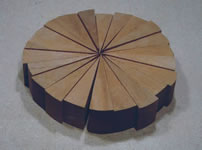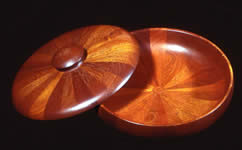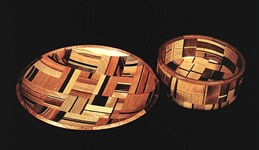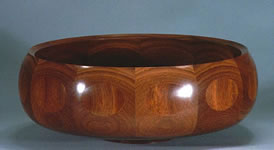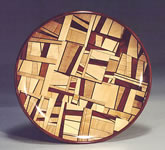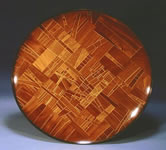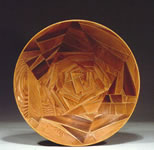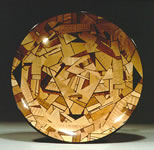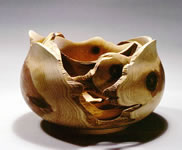
Early Woodturnings
1973 - 1988
My first woodturnings
were an extension of my lutherie work. The necks of my guitars were cut from
a solid piece of Honduran Mahogany, so every guitar neck cut created a nice,
wedge shaped, scrap (fig. 1). For some reason I saved all the wedges. One
day I did the obvious thing and glued some of these wedges into a solid block.
At about the same time I became the caretaker of a 1950's
vintage Craftsman lathe. I didn't know what I was going to do with this
big Mahogany pie, but the lathe and turning came to mind. Ultimately I scraped
several plates out of wedge blocks (Fig. 3). This was about 1973.
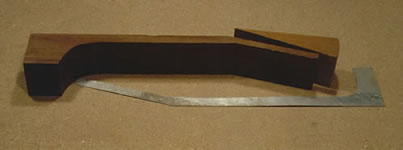 Figure 1 - a rough cut guitar neck and wedge |
|
It took about two years of guitar building to make enough wedges for a wedge plate. So after I had used up all of my available wedges I didn't do much with the lathe except an occasional small piece from solid wood.
The next major step forward came when my partner, Bonnie Carol, took up quilting. I had quite a collection of interesting wood scraps and, like a quilt, I pieced some together to make the bowls in the image below (fig. 4). Take note of the rims on these pieces, I made them that way to lock all the pieces together. When I started turning alabaster it was a natural move to put wood rims on the pieces to hold the stone together. These bowls were made about 1975.
While the above bowls were a hit with everyone who saw them, for my taste they were a bit haphazard. The next turnings (1976-1982) were a reaction to this. I started working with more regular patterns and using only one kind of wood in each piece, Fig. 5. With these pieces I developed some control over the patterns, but I missed the life of the earlier random pieces. In about 1983 I realized I could have quite a bit of control over the random factor and made the piece in Fig. 6. I had simplified the wood selection to Maple, Cherry, and Rosewood as well as putting some thought into what the end pattern would look like. With this piece I also started numbering my pieces. I estimated that I had made forty-five turnings and so started there. The system is still continuing and applies to all turnings, wood or alabaster.
This piece (#45) was a pivotal piece. It turned heads in the art department
at the University of Colorado, where I was studying painting, as well as in
galleries in New York City, where I was looking at painting. But the important
head that turned was that of Dale Nish.
It was spring of 1986, I had pretty much given up on painting and, looking for some new direction, signed up for a three day turning workshop in Denver. Dale was teaching the workshop. At break time on day two I showed this piece to Dale. Dale didn't miss a beat, he just asked politely if I wanted to sell it. I must have avoided answering. Unknown to Dale was that I had another, larger piece at home (Fig. 7). This larger piece was 24" in diameter and simply too big to easily cart around. Would Dale inquire about buying this one too? I brought it in the next day. By then though, I knew I needed to study the market and the time I was spending before I could come up with a price. But Dale had tipped me off that I had something - thanks Dale. (This was also the workshop where Lee Carter did a quick demonstration of alabaster turning, but that's another story - thanks to Lee also). Both of these pieces, Vessel #45 and Vessel #46, were accepted into the International Turned Objects Show of 1988.
By this time I had developed a system for building up the blocks which used less wood, after all, this wood is very time consuming to make and I wanted to stretch it as far as I could. (See the Square Plan section for more information). Then I came up with a second idea to conserve wood, while the first pieces were built up of squares and rectangles, I thought it would work even better to build up a block on a hexagonal plan (more information about the hex plan). The bowls in Figures 8 and 9 are an example of this design. Although I tried several times, the hex plan was always more trouble and somehow always felt like it used more wood than the square plan and so was abandoned.
Also from the late 80's were several experiments with natural edges and voids
(figure 10). Eventually I abandoned the wood altogether in favor of alabaster.
It's hard to say exactly why, I liked the precision of alabaster and the homogeneity
of the material. I'd also seen quite a bit of beautiful wood in my life and
the stone was new. There are still wood turnings I would like to make and if
I live long enough I probably will.
Home * Send
E-Mail * Site Map * Wood
Turning * Alabaster
Turning * Guitars * Shona
Music * Marimbas * Bio
© 2000 Max Krimmel non-commericial
duplication and distribution expected and encouraged
Max Krimmel - 15 Sherwood Road - Nederland, CO 80466 - 303.258.7763
